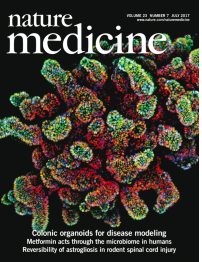Publications
Academic publications
Cholangiocyte organoids can repair bile ducts after transplantation in the human liver
By F. Sampaziotis et al Vol. 371, Issue 6531, pp. 839-846
Bile ducts carry bile from the liver and gall bladder to the small intestine, where it aids digestion. Cholangiocytes are epithelial cells that line bile ducts and modify bile as its transported through the biliary tree. Chronic liver diseases involving cholangiocytes account for a large fraction of liver failure and the need for liver transplantation. Because liver donors are in short supply, Sampaziotis et al. used organoid technology to develop a cell-based therapy using human tissue (see the Perspective by Kurial and Willenbring). Cholangiocyte organoids were transplanted into the intrahepatic ducts of deceased human donor livers undergoing ex vivo normothermic perfusion. The livers could be maintained for up to 100 hours, and the transplanted organoids engrafted, exhibited function, and could repair bile ducts.
Reconstruction of the mouse extrahepatic biliary tree using primary human extrahepatic cholangiocyte organoids
By F. Sampaziotis et al 23, pages 954–963 (2017)
The treatment of common bile duct (CBD) disorders, such as biliary atresia or ischemic strictures, is restricted by the lack of biliary tissue from healthy donors suitable for surgical reconstruction. Here we report a new method for the isolation and propagation of human cholangiocytes from the extrahepatic biliary tree in the form of extrahepatic cholangiocyte organoids (ECOs) for regenerative medicine applications. The resulting ECOs closely resemble primary cholangiocytes in terms of their transcriptomic profile and functional properties. We explore the regenerative potential of these organoids in vivo and demonstrate that ECOs self-organize into bile duct–like tubes expressing biliary markers following transplantation under the kidney capsule of immunocompromised mice. In addition, when seeded on biodegradable scaffolds, ECOs form tissue-like structures retaining biliary characteristics. The resulting bioengineered tissue can reconstruct the gallbladder wall and repair the biliary epithelium following transplantation into a mouse model of injury. Furthermore, bioengineered artificial ducts can replace the native CBD, with no evidence of cholestasis or occlusion of the lumen. In conclusion, ECOs can successfully reconstruct the biliary tree, providing proof of principle for organ regeneration using human primary cholangiocytes expanded in vitro.
Isolation and propagation of primary human cholangiocyte organoids for the generation of bioengineered biliary tissue
By O. Tysoe Nature Protocols – 14, pages 1884–1925 (2019)
Pediatric liver transplantation is often required as a consequence of biliary disorders because of the lack of alternative treatments for repairing or replacing damaged bile ducts. To address the lack of availability of pediatric livers suitable for transplantation, we developed a protocol for generating bioengineered biliary tissue suitable for biliary reconstruction. Our platform allows the derivation of cholangiocyte organoids (COs) expressing key biliary markers and retaining functions of primary extra- or intrahepatic duct cholangiocytes within 2 weeks of isolation. COs are subsequently seeded on polyglycolic acid (PGA) scaffolds or densified collagen constructs for 4 weeks to generate bioengineered tissue retaining biliary characteristics. Expertise in organoid culture and tissue engineering is desirable for optimal results. COs correspond to mature functional cholangiocytes, differentiating our method from alternative organoid systems currently available that propagate adult stem cells. Consequently, COs provide a unique platform for studies in biliary physiology and pathophysiology, and the resulting bioengineered tissue has broad applications for regenerative medicine and cholangiopathies.
Impact in the field
Building better
bile ducts
Publisher Science
Bioengineering the common bile duct
By Hugh Thomas
Publisher Nature Reviews



